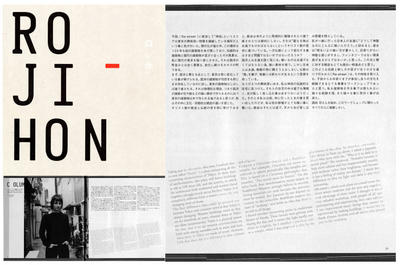Roji-Hon, Opinion, By Abel Erazo, Translation By Kanako Aoyama



SENDAI MEDIATECH`S LIBRARY, Sendai, Japan
Taking part in this time, I realized that an area called “Kanda” is a place compacting all the interesting characteristics of Tokyo. In these days of modernization, this place still leaves buildings as old as 100 years old; and the scenery, in which the architecture both traditional and Modern Tokyo, It is completely different from a western town; the ever changing town of chaos.
The first difference that could be pointed out between Tokyo and a western town is that Tokyo is always changing. Western buildings stand as they are for hundreds of years, whereas those in Tokyo are often reconstructed. There is a physical reason for this, that is to say western constructions are built with strong materials such as stone and iron, when those in Tokyo are made of wood. However, I felt that there also is a difference in idea, cultural and religious.
Compare a Christian church and a Buddhist temple, for example. Churches are never reinforced or rebuilt periodically like temples are. This is based on a Chrisitan philosophy that preaches, “the sacred must be forever”, On the other hand, does transformation matter largely to Buddhism? Westerns strongly believe in eternity. Strong materials are used because the precious must be eternal. But Japanese do not depend on eternity or the invincible. Buddhism respects the state of “nothing”, and holds an idea that there is an end to all things.
I found another interesting point in traditional houses of Kanda. Those houses were gloomy even during the day, and it seems like light hardly ever shine in brightly. So I recalled a previous visit to a temple, when I was surprised at first by the gloominess of the altar. In churches, contrarily, light shines in from up to above. I asked a Japanese friend who came with me, “Why is it so dark in a sacred place? She answered, “Probably because it feels more solemn and has inapproachable sanctity with darkness rather that brightness, and because it has a feeling of reality, not fantasy”., which took place on a small alley like above where tradition and the new mix together, took advantage of these traits. I thought it was a very valuable workshop, with people of all ages participating and experiencing their own culture. I took experienced many things that cannot be experienced by making buildings. I would like to thank Osamu Nishida and all others who played part in this workshop.
The first difference that could be pointed out between Tokyo and a western town is that Tokyo is always changing. Western buildings stand as they are for hundreds of years, whereas those in Tokyo are often reconstructed. There is a physical reason for this, that is to say western constructions are built with strong materials such as stone and iron, when those in Tokyo are made of wood. However, I felt that there also is a difference in idea, cultural and religious.
Compare a Christian church and a Buddhist temple, for example. Churches are never reinforced or rebuilt periodically like temples are. This is based on a Chrisitan philosophy that preaches, “the sacred must be forever”, On the other hand, does transformation matter largely to Buddhism? Westerns strongly believe in eternity. Strong materials are used because the precious must be eternal. But Japanese do not depend on eternity or the invincible. Buddhism respects the state of “nothing”, and holds an idea that there is an end to all things.
I found another interesting point in traditional houses of Kanda. Those houses were gloomy even during the day, and it seems like light hardly ever shine in brightly. So I recalled a previous visit to a temple, when I was surprised at first by the gloominess of the altar. In churches, contrarily, light shines in from up to above. I asked a Japanese friend who came with me, “Why is it so dark in a sacred place? She answered, “Probably because it feels more solemn and has inapproachable sanctity with darkness rather that brightness, and because it has a feeling of reality, not fantasy”.
By Abel Erazo/ ROJI-HON, Re-street Kanda, Column, Tokyo Metropolitan University COE Editors, April 2005, Tokyo

0 Comments:
Post a Comment
<< Home